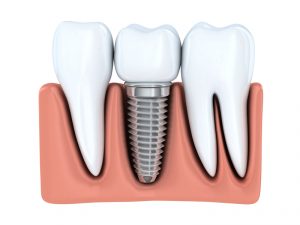 While modern dentistry offers many tooth replacement options, dental implants from Castle Rock dentist, L Blaine Kennington DDS, provide the most stable, bone-sparing and attractive smiles possible. Long-lasting alternatives to fixed bridges and full and partial dentures, dental implants definitely are the next best thing to real teeth.
While modern dentistry offers many tooth replacement options, dental implants from Castle Rock dentist, L Blaine Kennington DDS, provide the most stable, bone-sparing and attractive smiles possible. Long-lasting alternatives to fixed bridges and full and partial dentures, dental implants definitely are the next best thing to real teeth.
The Anatomy and Physiology of a Dental Implant
A dental implant is a true artificial tooth from root to crown. Made up of a titanium metal screw, or cylinder, a metal alloy abutment, or extension, and a porcelain crown, the single-tooth implant resides right in the empty tooth socket. Placed during a comfortable and simple oral surgery, the implant device requires several weeks to months of healing before completion with a crown or other restoration.
What makes a dental implant or implant-supported restoration, such as bridgework, unique is a natural process called osseointegration. Through osseointegration, the titanium in the screw-like device and the patient’s jaw bone actually meld together. Through normal use, the jaw bone gets exercised, strengthening it and bolstering its natural size. Other tooth replacements simply rest on the jawbone and gums, affording no benefit to density or shape.
Candidates for Dental Implant Procedure
To determine if an adult patient is a good candidate for dental implants, Dr. Kennington and his team look at several factors. The doctor performs a comprehensive oral evaluation to examine bone and gum health–both requirements for implant placement. If problems exist, the dentist can augment the bone and in the case of gum disease, perform the necessary treatments to heal the infection.
Dr. Kennington also likes patients to be diligent about their oral hygiene–brushing, flossing and getting routine dental check-ups and cleanings at Cowlitz River Dental. These practices decrease plaque and tartar build-up deleterious to implants and natural teeth alike.
Additionally, the implant patient should be in good overall health. Preferably, the individual does not smoke as tobacco usage degrades the gum tissue and bone around dental implants through an infection called peri-implantitis. While 95 percent or more of dental implant procedures are successful, peri-implantitis poses a serious threat and often requires implant removal.
The Dental Implant Treatment
To begin the treatment, Dr. Kennington incises the gums and drills a small hole in the jaw bone. Typically, this requires no more than a pain shot to numb the area. The dentist screws the implant device into the bone and closes the site with sutures.
After some weeks of healing time to allow the implant to integrate with the jaw and stabilize, the patient returns to the office for placement of the metal post and custom-fabricated crown. At this point, the procedure is complete. The patient goes home to care for his or her dental implant just as though it were a natural tooth.
Uses of Dental Implants
Besides single tooth replacement, multiple implants anchor bridgework and full and partial dentures for unparalleled aesthetics and oral function. With implant-supported prosthetics, patients enjoy stable eating and speaking with no dietary restrictions, speech slurring or gooey denture adhesives common to traditional restorations.
Dr. Kennington places dental implants using CBCT, or Cone Beam Computerized Tomography. This imaging system allows for very accurate insertion of one or more dental implants. As a certified Associate Fellow of the American Academy of Implant Dentistry, Dr. Kennington has the expertise and years of experience to ensure proper placement and long-term success of your dental implants.
Learn More
Dr. Kennington and his team would be happy to answer all your questions about this state of the art tooth replacement choice. After a restorative dentistry consultation, you well could be on your way to a stable, beautiful smile! Contact Cowlitz River Dental for an appointment.
